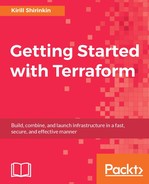It's been a lot of information in this chapter, but we finally know all the possible ways to supply configuration to Terraform templates. Let's recap what you learned.
You learned how to use variables in Terraform: what kind of variables we can use and how we can provide them interactively, inline, with environment variables and variable files. We also discovered data sources: a relatively new concept in Terraform that allows to get read-only data. While being still perhaps a bit too new, we found few applications for this concept. Then, you learned how to generate configuration files with the template_file data source and on top explored multiple other providers, all simplifying our configuration efforts. In the end, we even took a brief look into what Consul is and how it works with Terraform.
But Consul is not the only tool that you will want to use with Terraform. As Terraform is just a one utility in your infrastructure tool chain, you might be wondering how to connect it with other software. For example, how to connect it with configuration management tools? How to perform complex provisioning of servers? How to execute scripts after or during Terraform runs? In next chapter, you will learn everything about connecting Terraform with other software.
